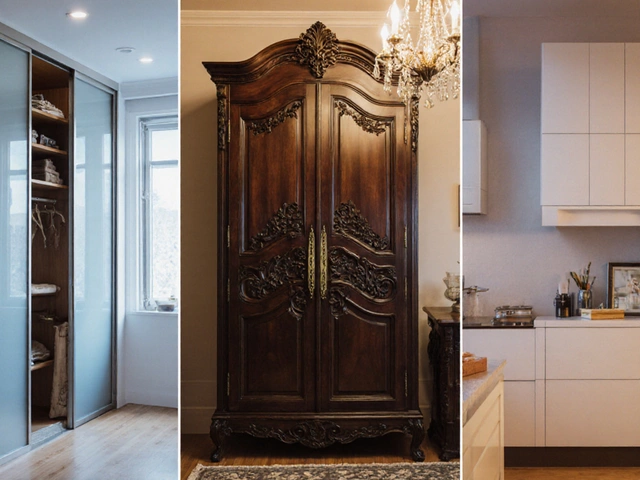 25
Jun,2025
25
Jun,2025
Bare walls, chunky stands, a new Smart TV just out of the box—the decision might seem simple at first, but mounting your TV on a wall or parking it on a stand can turn into a real debate. It’s not just about looks. Your choice can change how you enjoy movies, binge-watching sessions, even lazy Sunday game marathons. There’s more at stake than you realize—like safety, room dynamics, even whether your neck survives that three-season Netflix bender. So, before you break out the drill or dust off the entertainment unit, let’s break down what you should really think about.
The Look and Feel: How Setup Impacts Your Space
Ever notice how a TV can make or break a room’s vibe? Put it on a classic wood stand and you get retro living room energy, with space for your speaker, game console, and a stack of old DVDs. Mount that same screen high on the wall and suddenly, it’s all about modern minimalism. Turns out, this one decision has real design consequences. When you go with a TV stand, you’re pulling the screen closer to couches and easy chairs, which is awesome if you like hands-on interaction—switching out games or moving the screen without fuss. A TV stand can double as storage for remotes, extra cables, and your favorite snacks (come on, we all do it). It’s flexible, portable, and usually a breeze to set up—no tools or handyman appointment required. And if you rent? No worries about your landlord getting cranky over new holes in the drywall.
But stands can gobble up precious floor space, especially in tight apartments. They’re not always the safest choice around kids or big, energetic pets. Over 17,000 children are injured each year in TV tip-over accidents—yikes. Plus, dust bunnies love to collect under those shelves, and cleaning becomes its own Olympic sport. That’s why wall mounting has exploded in popularity. A wall-mounted TV practically floats, making small rooms feel bigger and cleaning a two-minute job.
Wall mounting lets you set the TV at perfect eye level—just like the pros do in movie theaters. The rule of thumb? Your eyes should hit about a third of the way up the screen when you’re sitting down. Want to get fancy? Consider an adjustable wall mount. It means you can tilt or swivel the TV to block glare from windows, or get the perfect angle from different spots on the couch. No stand in the way means you can arrange furniture more freely. And you can hide those ugly cords behind the wall with cable management kits (bonus points for keeping cats and kids away from stray wires).
Still, wall mounting isn’t for the faint of heart. Not all walls can handle a 75-inch monster TV, especially if you’ve got thin drywall or wobbly plaster—not something you want crashing down during movie night. It can cost extra to pay someone to do it right, and you’ll definitely need some DIY skills or patience for instructions. Change your mind about your room layout? Moving a 12-bolt wall mount to another wall isn’t a five-minute job.
Bottom line: If you want clean lines and room to stretch out, a wall mount brings big style points and practicality. If you’re after classic storage and instant flexibility, the tried-and-true TV stand might be your best TV placement tip yet.

Safety, Comfort, and Performance: Beyond the Aesthetics
Looks are only half the battle. When it comes to the health of your TV—and the people around it—safety is mission critical. TV tip-overs sent an estimated 11 children to the ER every single day in the US last year, according to Consumer Product Safety Commission stats. Stands can have anti-tip straps or anchors, but let’s face it: nothing beats a wall mount for out-of-reach security, especially if you’ve got curious toddlers or wild cats who treat your TV like a springboard.
Here’s another thing to think about: neck and eye comfort. Ever leave a friend’s house with a stiff neck because their TV felt just a bit... off? That’s not your imagination. A wall mount lets you put the TV dead-level with your eye line, avoiding the classic ‘TV too high above the fireplace’ syndrome—yes, that’s a thing. Put the screen too high and you’ll strain your neck; too low, and your posture takes a beating. A good rule—sit where you’ll watch from and map out the ideal spot with painter’s tape before hitting the wall with a drill.
For picture and sound quality, your setup really makes a difference. Placing the TV on a stand sometimes means the speakers get blocked by all the stuff you store underneath—think stacks of books, soundbars with owners’ manuals shoved underneath. With a wall mount, you can put your soundbar just under or above the TV, front and center, zero obstructions. Are you a surround sound nut? It’s easier to get speakers perfectly placed when you’re not limited by a chunky TV unit.
Got a gaming console or a favorite streaming box? Stands make it easy to swap out cables, plug in a thumb drive, or show off your latest gadget. With a wall mount, you’ll need some planning for shelves or cable boxes, though wall shelves and behind-TV organizers have gotten way fancier in the last couple years. Ever tried a TV swivel mount? You can sneak a look from the kitchen during game day without missing a beat. Wall mounts today support screens from a svelte 32 inches up to massive 86-inch OLEDs, usually no heavier than 150 pounds. Double-check your mount’s weight rating—and always find those wall studs, or grab a pro installer if you’re not sure. Major brands like Sanus and Vogel’s even offer mounts with built-in levels, so your screen won’t “lean” ever so annoyingly to one side.
Cost is another curveball. Wall mounting a TV (done right) can cost between $100 and $350 for professional installation, while a solid stand can run you $50 to $500 depending on style and material. Don’t forget hidden costs, like fixing the wall if you move out or covering up old drill holes. But with renters, you might be stuck with stands unless the lease allows mounting—or you’re willing to shell out for repairs.
Keep in mind, too, the safety of your tech investment. Stands are easier to bump or tip, especially with the chaos that sometimes happens in a busy home. Modern TVs are thinner (and wobblier) than ever, so giving them a safe perch is key.
| Setup | Average Initial Cost | Best For | Major Drawback |
|---|---|---|---|
| TV Stand | $50-$500 | Flexibility, Storage | More Floor Space, Tip-Over Risk |
| Wall Mount | $100-$350 install | Space Saving, Safety | Complex Installation, Less Flexibility |
Whatever you pick, try to future-proof the choice. Think about things like soundbars, smart lighting, maybe even how your TV works with voice assistants—there are stands with charging docks built in, and some wall mounts that hide Alexa or Google Nest speakers behind the panel. Don’t settle for “good enough”—optimize your TV viewing for your actual lifestyle now, and make sure it’ll still feel right as your needs shift. Your living room sanity depends on it.

Style, Storage, and Wires: Making It Work For You
Let’s talk about real life. The dream is a living room where every wire is tucked away, every gadget has a home, and the TV looks like a frame in a magazine. The reality? If you’re not careful, you end up with a rat’s nest of cables and a stack of game cases blocking the remote sensor. This is where the choice between a TV wall mount and a stand starts to matter more than you thought.
TV stands give you built-in storage, no fuss. Shelves for your PlayStation, bins for remotes, maybe even a spot for the router so WiFi isn’t lagging behind the couch. This comes in handy, especially if you’re the type who rotates gadgets or picks up a new streamer every Black Friday. And stands come in so many styles now—mid-century, industrial, open shelving, solid wood—so you’re not stuck buying whatever clunky option the big box store has in stock.
Wall mounts, on the other hand, open up all that precious space underneath. No more blocked baseboards or lost cable boxes lurking behind old magazines. Instead, you can choose to add floating shelves, a wall-mounted media console, or skip storage altogether and let your robot vacuum finally reach every corner. Minimalist? Wall mounting gives you the cleanest look—as long as you don’t skimp on cable management. Some people frame their wall-mounted TV with art, sound-absorption panels, or smart lighting strips to create a home theater vibe straight out of Pinterest.
Now, about those wires. With a stand, most cords just drop behind the furniture. Tidy it up with zip ties or cord sleeves, and it’s out of sight, out of mind—unless you have a clear-glass stand, in which case, get ready to dust and rearrange every week. Wall mounting means planning. You’ve got options: use cable covers painted to match your wall, chase the wires inside the drywall if your building allows, or run them through surface-mount plastic channels. Home improvement stores now sell everything from snap-on wire tracks to boxes that stow away power bricks and surge protectors.
Love to rearrange your space? Stands let you pivot with the seasons: open the sliding patio door in summer, huddle around your TV for winter movie nights. Wall-mounted TVs, though, anchor the screen to one spot. If you decide to move the furniture (or the TV itself), you’ve got some patching and painting ahead. One trick? Use an articulating mount with a wide range of motion so you can “aim” your TV at different seats.
Want to boost your style points? TV manufacturers are stepping up their game with ultra-slim frames and stands that double as designer pieces. TV frames like Samsung’s The Frame blend into gallery walls when you’re not binge-watching. Some wall mounts even include magnetic covers and backlights for dramatic movie-night mood.
Let’s wrap with a few pro tips:
- Measure your TV and room before you commit to either setup. Don’t guess—grab a tape measure so you know you’ll get that cinema feel without neck pain.
- If you rent, check your lease. Some places charge damage fees if you drill, but they might allow specific wall anchors or removable mounts.
- Keep a copy of your TV’s VESA size specs—the mounting hole pattern—so you don’t get stuck with the wrong bracket.
- If you have pets or kids, look into anti-tip kits for stands or triple-check wall anchors for mounts.
- For the best viewing, aim for the center of the screen to land at your seated eye level, usually 42–48 inches from the floor.
At the end of the day, there’s no single right answer—*tv wall mount* or stand—just what feels right for your space, your style, and, most of all, your comfort. Pick a setup you love, make it safe and smart, and that living room marathon just got a serious upgrade.




